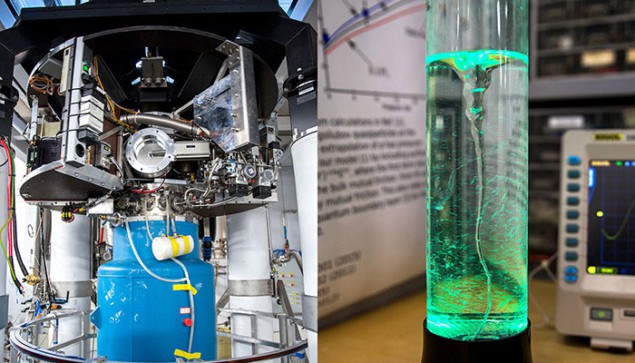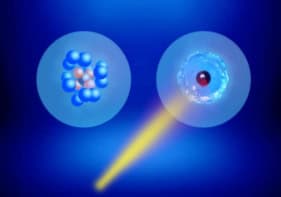
Quasiparticles within a rotating sample of superfluid helium-3 create unexpected friction in a material that is supposed to undergo frictionless flow, according to Jere Mäkinen and Vladimir Eltsov at Aalto University in Finland. Their discovery could have a wide range of applications from neutron stars to quantum computers.
Helium-3 atoms are fermions, which pair up at ultracold temperatures to form bosons that can then create a superfluid – a fluid with zero viscosity that undergoes frictionless flow. This pairing interaction is somewhat similar to what happens to electrons in superconductors and could also occur to neutrons within the cores of a neutron stars.
Physicists know of two distinct phases of superfluidity in helium-3. The B phase occurs at low pressure and low temperature, whereas the A phase occurs at higher pressures and temperatures.
In a spin
In their experiment, Mäkinen and Eltsov rotate a cylindrical container of the B-phase superfluid, which created vortexes within the helium-3. The container is then stopped from rotating and the pair monitor the continuing rotation of the superfluid using nuclear magnetic resonance and two quartz tuning forks that are immersed at the bottom of the container.
These vortexes should rotate in a smooth and stable manner and should not be able to exchange kinetic energy with their surroundings. Instead, the physicists observe deviations from vortexes with perfect cylindrical symmetry that lead to turbulence. This indicates that the helium-3 is not flowing in a perfectly frictionless manner.
Writing in Physical Review B, Mäkinen and Eltsov suggest that the source of this friction is quasiparticles that become trapped within the cores of vortexes. As the vortexes accelerate, the quasiparticles gain energy, which they can then dissipate to their surroundings in the form of friction.
Neutron star glitches
Understanding how to minimize this type of friction could be important to those trying to boost the performance of components for superconductor-based quantum computers, which involve the flow of superfluid-like supercurrents. The energy-dissipation process observed at Aalto could also provide insight into the physics of neutron stars, which are believed to have a superfluid component in their cores. Unexplained sudden changes in the rotation speeds of some neutron stars – called “glitches” – could be caused by a similar phenomenon, for example.
The research could even provide insights into why turbulence occurs in everyday materials, something that has proven very difficult to calculate.



